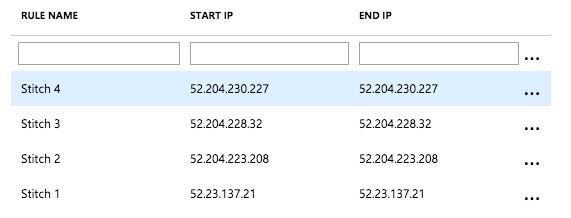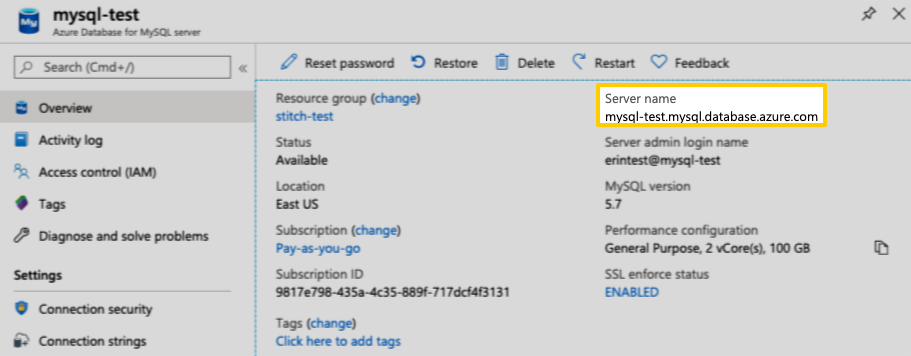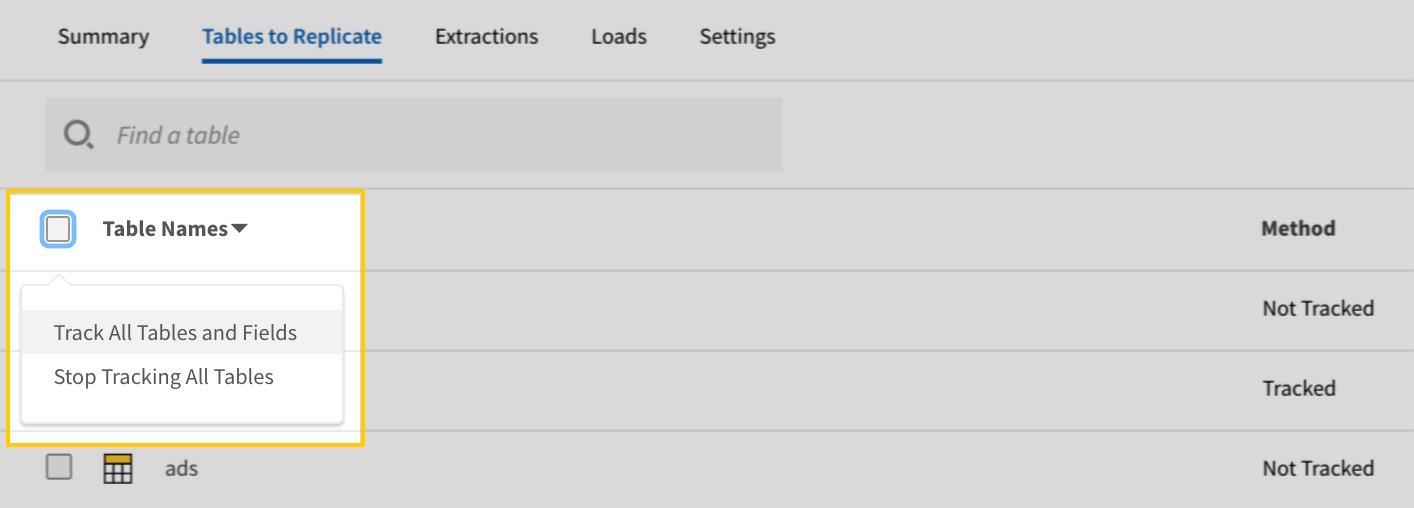This integration is powered by Singer's MySQL tap and certified by Stitch. Check out and contribute to the repo on GitHub.
For support, contact Support.
Microsoft Azure MySQL feature snapshot
A high-level look at Stitch's Microsoft Azure MySQL (v1) integration, including release status, useful links, and the features supported in Stitch.
| STITCH | |||
| Release status |
Deprecated on November 8, 2021 |
Supported by | |
| Stitch plan |
Standard |
Supported versions | |
| API availability |
Not available |
Singer GitHub repository | |
| CONNECTION METHODS | |||
| SSH connections |
Supported |
SSL connections |
Supported |
| REPLICATION SETTINGS | |||
| Anchor Scheduling |
Supported |
Advanced Scheduling |
Supported |
| Table-level reset |
Supported |
Configurable Replication Methods |
Supported |
| REPLICATION METHODS | |||
| Log-based Replication |
Supported |
Key-based Replication |
Supported |
| Full Table Replication |
Supported |
||
| DATA SELECTION | |||
| Table selection |
Supported |
Column selection |
Supported |
| View replication |
Supported |
Select all |
Supported, with prerequisites |
| TRANSPARENCY | |||
| Extraction Logs |
Supported |
Loading Reports |
Supported |
Connecting Microsoft Azure MySQL
Microsoft Azure MySQL setup requirements
To set up Microsoft Azure MySQL in Stitch, you need:
-
The
CREATE USERorINSERTprivilege (for themysqldatabase). TheCREATE USERprivilege is required to create a database user for Stitch. -
The
GRANT OPTIONprivilege in Microsoft Azure MySQL. TheGRANT OPTIONprivilege is required to grant the necessary privileges to the Stitch database user. -
If using Log-based Incremental Replication:, you’ll need:
- Privileges in Microsoft Azure that allow you to modify server parameters.
- A master server that adheres to Microsoft’s requirements.
- A MySQL database running MySQL version 5.6.2 or newer.
Step 1: Verify your Stitch account's data pipeline region
First, you’ll log into Stitch and verify the data pipeline region your account is using. Later in this guide, you’ll need to grant Stitch access by whitelisting our IP addresses.
The IP addresses you’ll whitelist depend on the Data pipeline region your account is in.
- Sign into your Stitch account, if you haven’t already.
- Click User menu (your icon) > Edit User Settings and locate the Data pipeline region section to verify your account’s region.
-
Locate the list of IP addresses for your region:
Keep this list handy - you’ll need it later.
Step 2: Configure database connection settings
In this step, you’ll configure the database server to allow traffic from Stitch to access it. There are two ways to connect your database:
- A direct connection will work if your database is publicly accessible.
- An SSH tunnel is required if your database isn’t publicly accessible. This method uses a publicly accessible instance, or an SSH server, to act as an intermediary between Stitch and your database. The SSH server will forward traffic from Stitch through an encrypted tunnel to the private database.
Click the option you’re using below and follow the instructions.
For the connection from Stitch to be successful, you’ll need to configure the firewall for your instance to allow access from IP addresses for your Stitch data pipeline region.
-
Sign into your Microsoft Azure portal.
- Locate and open the database you want to connect to Stitch.
-
Click Settings > Connection security.
- For each of the IP addresses you retrieved in Step 1 for your Stitch data pipeline region, create a rule:
- Rule name: Enter a name for the rule. For example:
Stitch<number> - Start IP: Paste one of the Stitch data pipeline region IP addresses.
- End IP: Paste the same IP address.
- Rule name: Enter a name for the rule. For example:
- Click the three dots to the right of the End IP field to add the rule.
-
Repeat steps 4 and 5 until there is a rule for each IP address for your Stitch data pipeline region. Below is an example of what this might look like using Stitch’s North America IP addresses:

Note: You may also want to add your own IP address(es) to this list. This ensures that you’ll also be able to connect to the database as needed.
- Click Save.
- Follow the steps in the Setting up an SSH Tunnel for a Microsoft Azure database guide to set up an SSH tunnel for Microsoft Azure MySQL.
- Complete the steps in this guide after the SSH setup is complete.
Step 3: Configure Log-based Incremental Replication
Important: Requirements for configuring binlog replication
To use binlog replication, your Microsoft Azure MySQL database must be running MySQL version 5.6.2 or greater.
Additionally, setting up binlog replication requires rebooting your database to ensure parameter changes take effect. To minimize disruptions, we recommend performing the reboot during non-peak usage hours.
While Log-based Incremental Replication is the most accurate and efficient method of replication, using this replication method may, at times, require manual intervention or impact the source database’s performance. Refer to the Log-based Incremental Replication documentation for more info.
You can also use one of Stitch’s other Replication Methods, which don’t require any database configuration. Replication Methods can be changed at any time.
Step 3.1: Configure server settings
- In your Azure portal, locate and open the Azure Database for MySQL database you want to connect to Stitch.
- Click Settings > Server Parameters.
-
Define the following server settings:
-
binlog_row_image-FULL -
binlog_expire_logs_seconds-604800 -
log_slave_updates-1
Refer to the Server settings list tab for more info about these settings.
-
- Click Save when finished.
- When finished, restart your MySQL server to ensure the changes take effect.
In the table below are the names, required values, and descriptions of the server settings you must define.
| Setting | Value | Description |
| binlog_row_image |
FULL
|
Note: This setting is available on Microsoft Azure MySQL databases running version 5.6.2 or greater. Defines how row images are written to the binary log. A |
| binlog_expire_logs_seconds |
604800
|
Specifies the amount of time, in seconds, before the automatic removal of binary log files. Stitch recommends a retention period of 7 days, but a minimum of 3 days will also work. Note: This variable is available on MySQL versions 8.0.1+. |
| log_slave_updates |
1
|
Indicates whether updates received by a read replica from a master server should be logged to the replica’s own binary log. Note: This is applicable when using a read replica. |
Step 3.2: Retrieve server IDs
Required for Log-based Replication
This step is required if using Log-based Replication and any of the following are true:
- You’re connecting a read replica to Stitch
- You’re connecting multiple databases to Stitch, all of which are on the same Microsoft Azure MySQL server. These can be read replicas, or databases on the master instance.
- You’re adding a new Microsoft Azure MySQL Stitch integration, and the database is on the same server as other previously-connected databases.
When Stitch connects to your database and uses Log-based Replication, a unique server ID will be required. This ID ensures that the integration - or integrations, if you’re connecting multiple databases - will not encounter conflicts during the replication process.
To avoid conflicts, you’ll check which server IDs are currently in use and then define a new, unqiue ID in Stitch.
- Log into the MySQL server that acts as the replication master.
-
Run the following statement:
mysql> SHOW SLAVE HOSTS; -
The
SHOW SLAVE HOSTSstatement will return information about servers that are or have been connected as replication slaves:+------------+-------------+------+-----------+------------+ | Server_id | Host | Port | Master_id | Slave_UUID | +------------+-------------+------+-----------+------------+ | 192168010 | stitch_prod | 3306 | 192168011 | <UUID> | | 1921680101 | stitch_dev | 3306 | 192168011 | <UUID> | +------------+-------------+------+-----------+------------+
When you complete the setup in Stitch, you’ll define a unique server ID for your Stitch Microsoft Azure MySQL integration to use.
Step 4: Create a Stitch database user
CREATE USER and GRANT OPTION privileges to complete this step.
Next, you’ll create a dedicated database user for Stitch. This will ensure Stitch is visible in any logs or audits, and allow you to maintain your privilege hierarchy.
- Log into your database as a user with
CREATE USERandGRANT OPTIONprivileges. -
Run the following command to create the Stitch database user:
CREATE USER '<stitch_username>'@'localhost' IDENTIFIED BY '<password>';Replace
<password>with a secure password. If using SSH, this can be different than the SSH password. -
Grant the Stitch user
SELECTprivileges by running this command for every table you want to replicate:GRANT SELECT ON '<database_name>'.'<table_name>' to '<stitch_username>'@'localhost';Limiting access to only the tables you want to replicate ensures that the integration can complete discovery (a structure sync) in a timely manner. If you encounter issues in Stitch where tables aren’t displaying, try limiting the Stitch database user’s table access.
Note: Column-level permissions are not supported for use with Log-based Incremental Replication. Restricting access to columns will cause replication issues.
Important: Using Log-based Incremental Replication
Additionally, if you want to use Log-based Incremental Replication, you’ll also need to grant the Stitch user replication privileges:
GRANT REPLICATION CLIENT, REPLICATION SLAVE ON *.* TO '<stitch_username>'@'localhost';
See the Privileges list tab for an explanation of why these permissions are required by Stitch.
In the table below are the database user privileges Stitch requires to connect to and replicate data from a Microsoft Azure MySQL database.
| Privilege name | Reason for requirement |
| SELECT |
Required to select rows from tables in a database. |
| REPLICATION CLIENT |
Required for binlog replication. Required to use |
| REPLICATION SLAVE |
Required for binlog replication. Required to use |
Step 5: Connect Stitch
In this step, you’ll complete the setup by entering the database’s connection details and defining replication settings in Stitch:
Step 5.1: Locate connection details
In this step, you’ll retrieve the server address for the Microsoft Azure MySQL you want to connect to Stitch.
This is the value you’ll enter in the Host field in Stitch in the next step.
- From your Azure dashboard, click Azure Database for MySQL Server.
- On the page that displays, click the name of the database you want to connect to Stitch.
-
The details page for the database will display. On this page, locate the Server name field, which is highlighted below:

Step 5.2: Define the database connection details
- If you aren’t signed into your Stitch account, sign in now.
-
On the Stitch Dashboard page, click the Add Integration button.
- Locate and click the MySQL icon.
-
Fill in the fields as follows:
-
Integration Name: Enter a name for the integration. This is the name that will display on the Stitch Dashboard for the integration; it’ll also be used to create the schema in your destination.
For example, the name “Stitch Microsoft Azure MySQL” would create a schema called
stitch_microsoft_azure_mysqlin the destination. Note: The schema name cannot be changed after the integration is saved. -
Integration Name: Paste the Server name you retrieved in the previous step. This should be similar to
<database-name>.mysql.database.azure.com. -
Port: Enter the port used by the Microsoft Azure MySQL instance. The default is
3306. -
Username: Enter the Stitch Microsoft Azure MySQL database user’s username.
-
Password: Enter the password for the Stitch Microsoft Azure MySQL database user.
-
Step 5.3: Define the SSH connection details
If you’re using an SSH tunnel to connect your Microsoft Azure MySQL database to Stitch, you’ll also need to define the SSH settings. Refer to the Setting up an SSH Tunnel for a Microsoft Azure database guide for assistance with completing these fields.
-
Click the SSH Tunnel checkbox.
-
Fill in the fields as follows:
-
SSH Host: Enter the public IP address or hostname of the server Stitch will SSH into.
-
SSH Port: Enter the SSH port on your server. (
22by default) -
SSH User: Enter the Stitch Linux (SSH) user’s username.
-
Step 5.4: Define the SSL connection details
-
Check the Connect using SSL checkbox. Note: The database must support and allow SSL connections for this setting to work correctly.
-
Fill in the fields as follows:
-
SSL Certificate: The certificate (typically a CA or server certificate) Stitch should verify the SSL connection against. The connection will succeed only if the server’s certifcate verifies against the certificate provided.
Note: Providing a certifcate via this property isn’t required to use SSL. This is only if Stitch should verify the connection against a specific certificate.
-
Use an SSL client key: If SSL client authentication should be used, check this box. This will display the Client Certificate and Client Key fields, which are both required when using client authentication.
-
Client Certificate: If using SSL client authentication, paste the client certificate Stitch should use into this field. Note: You must also provide a Client Key for the connection to be successful.
-
Client Key: If using SSL client authentication, paste the client key Stitch should use into this field. Note: You must also provide a Client Certificate for the connection to be successful.
-
Step 5.5: Define the Log-based Replication setting
In the Log-based Replication section, you can set this as the integration’s default Replication Method.
When enabled, tables that are set to replicate will use Log-based Incremental Replication by default. If you don’t want a table to use Log-based Incremental Replication, you can change it in the Table Settings page for that table.
If this setting isn’t enabled, you’ll have to select a Replication Method for each table you set to replicate.
Step 5.6: Create a replication schedule
In the Replication Frequency section, you’ll create the integration’s replication schedule. An integration’s replication schedule determines how often Stitch runs a replication job, and the time that job begins.
Microsoft Azure MySQL integrations support the following replication scheduling methods:
-
Advanced Scheduling using Cron (Advanced or Premium plans only)
To keep your row usage low, consider setting the integration to replicate less frequently. See the Understanding and Reducing Your Row Usage guide for tips on reducing your usage.
Step 5.7: Save the integration
When finished, click Check and Save.
Stitch will perform a connection test to the Microsoft Azure MySQL database; if successful, a Success! message will display at the top of the screen. Note: This test may take a few minutes to complete.
Step 6: Select data to replicate
The last step is to select the tables and columns you want to replicate.
Note: If a replication job is currently in progress, new selections won’t be used until the next job starts.
For Microsoft Azure MySQL integrations, you can select:
-
Individual tables and columns
-
All tables and columns (except views)
-
Database views
Click the tabs to view instructions for each selection method.
- In the Integration Details page, click the Tables to Replicate tab.
- Locate a table you want to replicate.
-
Click the checkbox next to the table’s name. A blue checkmark means the table is set to replicate.
-
After you set a table to replicate, a page with the table’s columns will display. De-select columns if needed.
- Next, you’ll define the table’s Replication Method. Click the Table Settings button.
- In the Table Settings page:
-
Define the table’s Replication Method, or skip this step if you want to use the integration’s default method.
-
If using Key-based Incremental Replication, select a Replication Key.
-
When finished, click Update Settings.
-
-
Repeat this process for every table you want to replicate.
- Click the Finalize Your Selections button at the bottom of the page to save your data selections.
Important: Before using this feature, note that:
-
Using the Select All feature will overwrite any previous selections. However, selections aren’t final until Finalize Your Selections is clicked. Clicking Cancel will restore your previous selections.
-
Log-based Incremental Replication must be enabled and set as the default Replication Method to use the Select All feature.
Refer to the Select All guide for more info about this feature.
- Click into the integration from the Stitch Dashboard page.
-
Click the Tables to Replicate tab.
-
Navigate to the table level, selecting any databases and/or schemas that contain tables you want to replicate.
- In the list of tables, click the box next to the Table Names column.
-
In the menu that displays, click Track AllTables and Fields (Except Views):

- Click the Finalize Your Selections button at the bottom of the page to save your data selections.
Setting a database view to replicate is similar to selecting a table, with a few differences. Refer to the Replicating Database Views guide for detailed instructions.
At a high level, you’ll need to complete the following to select a database view:
Initial and historical replication jobs
After you finish setting up Microsoft Azure MySQL, its Sync Status may show as Pending on either the Stitch Dashboard or in the Integration Details page.
For a new integration, a Pending status indicates that Stitch is in the process of scheduling the initial replication job for the integration. This may take some time to complete.
Initial replication jobs with Anchor Scheduling
If using Anchor Scheduling, an initial replication job may not kick off immediately. This depends on the selected Replication Frequency and Anchor Time. Refer to the Anchor Scheduling documentation for more information.
Free historical data loads
The first seven days of replication, beginning when data is first replicated, are free. Rows replicated from the new integration during this time won’t count towards your quota. Stitch offers this as a way of testing new integrations, measuring usage, and ensuring historical data volumes don’t quickly consume your quota.
| Related | Troubleshooting |
Questions? Feedback?
Did this article help? If you have questions or feedback, feel free to submit a pull request with your suggestions, open an issue on GitHub, or reach out to us.